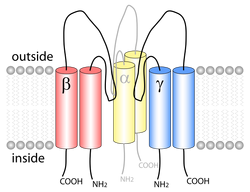Assessment |
Biopsychology |
Comparative |
Cognitive |
Developmental |
Language |
Individual differences |
Personality |
Philosophy |
Social |
Methods |
Statistics |
Clinical |
Educational |
Industrial |
Professional items |
World psychology |
Biological: Behavioural genetics · Evolutionary psychology · Neuroanatomy · Neurochemistry · Neuroendocrinology · Neuroscience · Psychoneuroimmunology · Physiological Psychology · Psychopharmacology (Index, Outline)

schematic picture of an ENaC (the second α-subunit is omitted for clarity).
The epithelial sodium channel (short: ENaC, also: sodium channel non-neuronal 1 (SCNN1) or amiloride sensitive sodium channel (ASSC)) is a membrane-bound ion-channel that is permeable for Li+-ions, protons and especially Na+-ions. It is a constitutively active ion-channel. It is arguably the most selective ion channel.
Structure[]
ENaC is a heterotetrameric protein consisting of four subunits, two of which are identical (α2, β, γ). Each of the subunits consists of two transmembrane helices and an extracellular loop. The amino- and carboxy-termini of all polypeptides are located in the cytosol.
Location and function[]
ENaC is located in the apical membrane of polarized epithelial cells particularly in the kidney, the lung and the colon. It is involved in the transepithelial Na+-ion transport which it accomplishes together with the Na+/K+-ATPase.
It plays a major role in the Na+- and K+-ion homeostasis of blood, epithelia and extraepithelial fluids by resorption of Na+-ions. The activity of ENaC in colon and kidney is modulated by the mineralcorticoid aldosterone. It is blocked by amiloride, which is used in medical science, where amiloride serves as diuretic.
ENaC can furthermore be found in taste receptor cells, where it plays an important role in salt taste perception. In rodents virtually the entire salt taste is mediated by ENaC, whereas it seems to play a less significant role in humans: about 20 percent can be accredited to the epithelial sodium channel.
δ-subunit[]
In addition there is a fourth, so-called δ-subunit, that shares considerable sequence similarity with the α-subunit and can form a functional ion-channel together with the β- and γ-subunits. Such δ2, β, γ-tetrameres appear in pancreas, testes and ovaries. Their function is yet unknown.
Clinical significance[]
Units β and γ are associated with Liddle's syndrome.[1]
Genes[]
References[]
External links[]
Membrane transport protein: ion channels
| |
|---|---|
| Ca | Voltage-dependent calcium channel (L-type/CACNA1C, N-type, P-type, Q-type, R-type, T-type) - Inositol triphosphate receptor - Ryanodine receptor - Cation channels of sperm |
| Na: Sodium channel | Nav1.4 - Nav1.5 - Nav1.7 - Epithelial sodium channel |
| K: Potassium channel | Voltage-gated (KvLQT1, KvLQT2, KvLQT3, HERG, Shaker gene, KCNE1) - Calcium-activated (BK channel, SK channel) - Inward-rectifier (ROMK, KCNJ2) - Tandem pore domain |
| Cl: Chloride channel | Cystic fibrosis transmembrane conductance regulator |
| Porin | Aquaporin (1, 2, 3, 4) |
| Transient receptor potential | TRPA - TRPC (TRPC6) - TRPM (TRPM6) - TRPML (Mucolipin-1) - TRPP - TRPV (TRPV1, TRPV6) |
| Other/general | Gap junction - Stretch-activated ion channel - Ligand-gated ion channel - Voltage-gated ion channel - Cyclic nucleotide-gated ion channel - Two-pore channel |
- de:Epithelialer Natriumkanal
- ko:상피 세포 소듐 채널
| This page uses Creative Commons Licensed content from Wikipedia (view authors). |